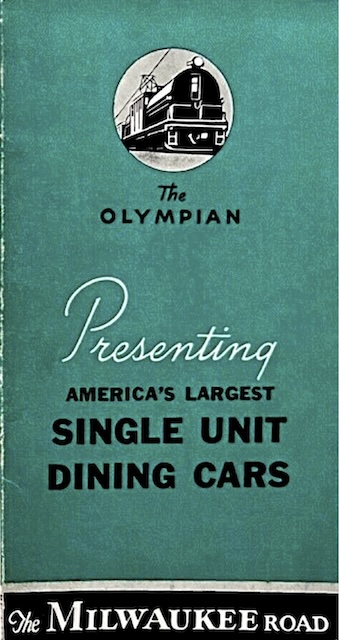Although the fully streamlined Olympian Hiawatha would not be introduced until 1947, the Milwaukee Road introduced lightweight, streamlined cars to the Olympian eleven years earlier. These included some head-end cars, coaches, and the diners that are the subject of this brochure. Sleeping cars and the observation-lounge cars remained heavyweights.
 Click image to download a 2.9-MB PDF of this brochure.
Click image to download a 2.9-MB PDF of this brochure.
The new cars were built by Milwaukee Road’s own shops, necessitated by the fact that the company had once again gone bankrupt in 1935. Based on the early Hiawatha cars, the cars were innovative in many ways, particularly in their wheel sets designed by Milwaukee Road engineer Karl F. Nystrom. Someone who rode the Hiawathas once noted that the Milwaukee had the worst tracks in the Chicago-Minneapolis corridor, but its cars’ suspension systems were so good that it offered the most comfortable ride. As this brochure says, “roller bearings, rubber-mounted trucks, and careful insulation” made the cars “quiet and smooth riding.”
I am grateful to Streamliner Memories reader James Ingram for providing scans of this brochure, which points out that standard diners of the period typically had only 30 seats (though many had 36), meaning five or six rows of tables with four seats on one side of the aisle and two seats on the other side. The new cars had 48 seats, meaning six rows with four seats on both sides of the aisle. This meant narrower aisles, but more customers could be served at one time. The brochure somehow made the claim that the diners were “the roomiest and most modern restaurants on wheels,” but more seats actually meant passengers had a little less elbow room.
By the 1950s, 48 seats had become standard for most railroad dining cars. A few railroads — New York Central, Pennsylvania, and Southern Pacific — had multi-unit diners with a kitchen in one unit and dining room in another, which made room for a lot more seats and is why this brochure specifies the Olympian cars were the larges “single-unit dining cars.”
This brochure also provides some sample menus. A “Chef’s Selection” dinner with meat, fish, or egg entrée was 50¢; a fancier dinner with a choice of entrées, soup, potatoes, vegetable, bread, dessert, and beverage was 65¢; and a full table d’hôte meal with appetizer, soup, salad, entrée, potatoes, vegetable, bread, dessert, a cheese plate, and beverage ranged from $1 with a trout entrée to $1.25 with a steak entrée. Multiplying by 22 to get today’s prices still makes the meals seem a bargain.
